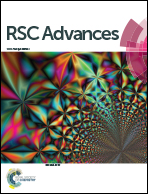Room temperature synthesis of an amorphous MoS2 based composite stabilized by N-donor ligands and its light-driven photocatalytic hydrogen production†
Abstract
Herein an entirely new and simple room temperature synthesis of an amorphous molybdenum sulfide stabilized by complexing ammonia and hydrazine is reported. The resulting material exhibits an outstanding activity for the photocatalytic hydrogen evolution driven by visible light. It is chemically stable during the reaction conditions of the photocatalysis and shows unusual thermal stability up to 350 °C without crystallization. The new material is obtained by a reaction of solid ammonium tetrathiomolybdate and gaseous hydrazine. In the as-prepared state Mo atoms are surrounded by μ2-briding S2−, NH3 and hydrazine, the latter being coordinated to Mo(IV) in a bridging or side-on mode. Heating at 450 °C or irradiation with an electron beam generates nanosized crystalline MoS2 slabs. The two modes for crystallization are characterized by distinct mechanisms for crystal growth. The stacking of the slabs is low and the material exhibits a pronounced turbostratic disorder. Heat treatment at 900 °C yields more ordered MoS2 but structural disorder is still present. The visible-light driven hydrogen evolution experiments evidence an outstanding performance of the as-prepared sample. The materials were thoroughly characterized by optical spectroscopy, chemical analysis, in situ HRTEM, XRD, 1H and 15N solid-state NMR, XPS, and thermal analysis.


 Please wait while we load your content...
Please wait while we load your content...